Vintage Longines military and diving watches

Published: Aug 02, 2022
An introduction to Longines’ Vintage Military and Dive watches
Longines has always enjoyed a close relationship with several military organisations. The St-Imier-based watchmaker played an integral role in developing and supplying tool watches for military forces in the Second World War, particularly the British Army and the British Royal Air Force. In this article, we’re going to look at the relationship between Longines and the military, and in particular, the influence it had in developing Czechoslovak military watches, along with some of the Swiss brand’s earlier dive watches.
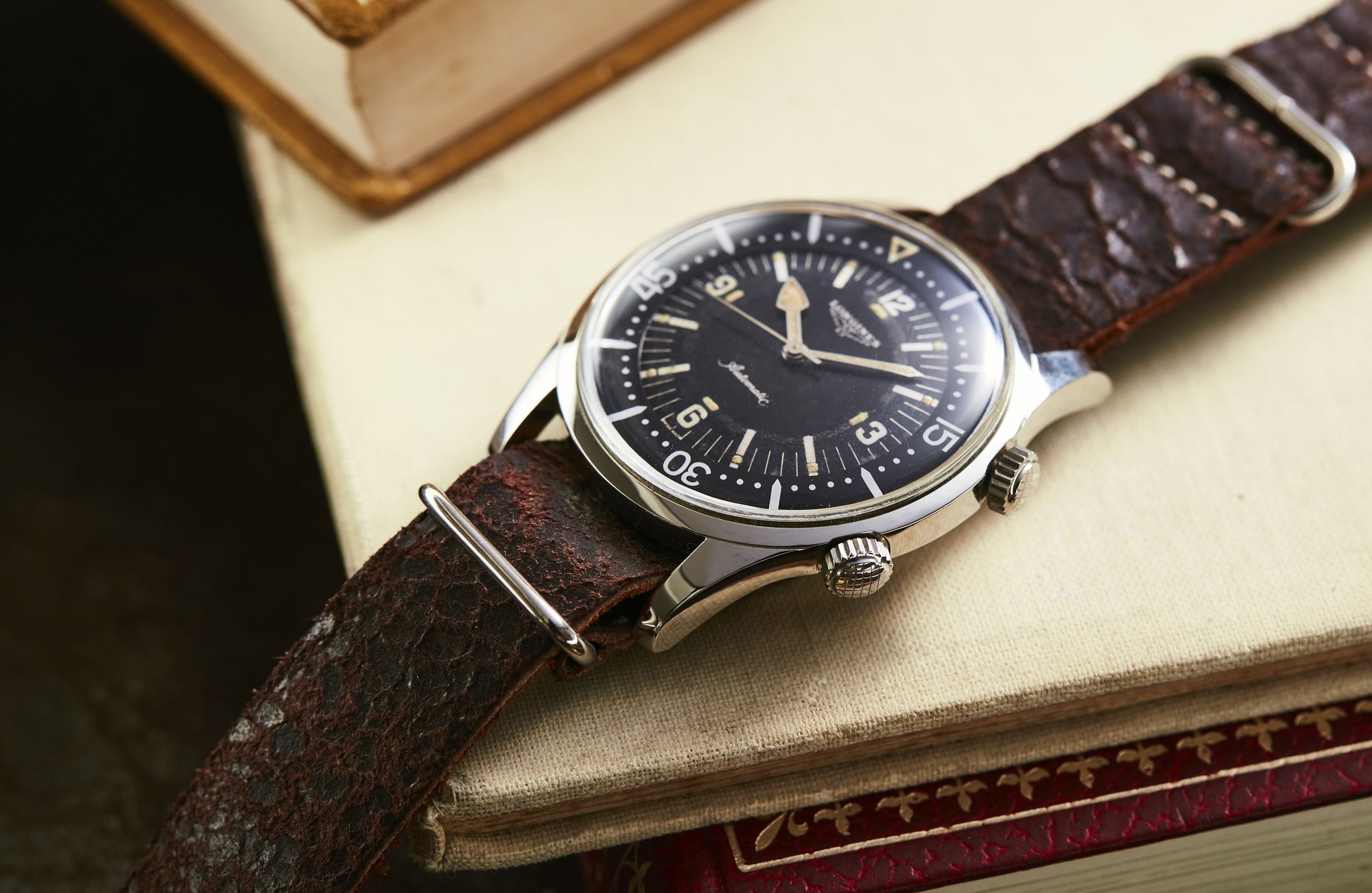
Longines and the military
As aforementioned, Longines has always been inextricably linked to military tool watches. Prior to WWII, however, Longines had developed an important pilot’s watch. It was first trialled by the pilot, Charles Lindbergh, who used its innovative inner rotating bezel to help navigate his aircraft across the Atlantic in 1927. Two years later, the watch was improved with the help of Captain Philip Van Horn Weems of the U.S. Naval Academy and the Longines Weems Second Setting watch was released. It enabled the wearer to synchronise the watch with a precise source of time like a radio signal. The watch measured a large 48mm diameter and featured either a rotating bezel or a central sub-dial to use as a 60-second scale for its synchronisation process.
The Longines Hour Angle watch marked the beginning of the brand’s role in supplying military wristwatches to the forces during the Second World War. It was an evolution of the technology used in the Weems watch, but also enabled pilots to measure longitude based on time with its advanced technology. Longines, alongside many other leading watch brands, was also called upon by the British Ministry of Defence to manufacture watches for its soldiers – a group that would be nicknamed the “Dirty Dozen”.
One other notable watch produced by Longines during the Second World War was the Greenlander. It featured a large case measuring 38mm and had the WWW letters inscribed into its caseback. The letters stand for “watch”, “wrist”, and “waterproof”. One of its hallmarks was the Broad Arrow head, which could be seen on the dial, the inner case and the back of the case.
All three of these vintage Longines military watches; the Hour Angle, the Weems, and the Greenlander have been reinterpreted as modern editions in the brand’s popular Heritage collection today.
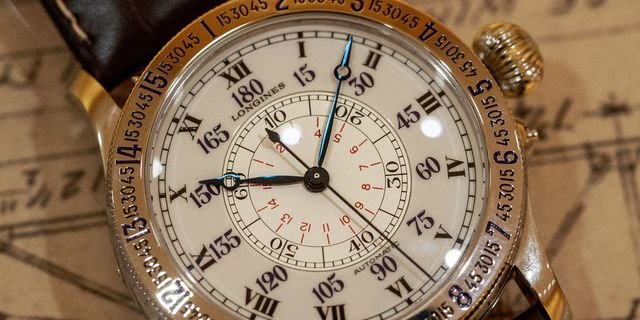
Longines and its Czechoslovak military watches
One story that is often forgotten about is Longines’ contribution to watches for the Czechoslovak Air Force. The First Czechoslovak Republic had a particularly well-equipped air force and part of this was due to having a reliable wristwatch supplied as part of its equipment. Longines has always upheld a respectable reputation for developing reliable and accurate pilot’s watches – one of them being the Longines Majetek. The model was actually commissioned by the Czechoslovak military and produced by a few different companies, so it was not exclusively developed by Longines. The 1935 model supplied by Longines, however, was well-utilized by the Czechoslovak military and boasted a distinct cushion-shaped case that looked similar to a Panerai watch.
One of the key aspects of the Longines Majetek watch was its legibility. High-stress situations experienced once air bound meant that 20th-century pilots relied on a watch that could provide information instantly at a glance. To improve readability in dimly-lit conditions, the Longines Majetek watch featured a black enamel dial with crisp white Arabic numerals. This Czechoslovak military watch also featured an internal rotating bezel and a triangular marker set at the 12 o’clock location. Although developed from the mid-1930s, the first model to be released by Longines comprised several components that were made in different time periods, like the case, made in the 1920s and the Calibre 15.94 later developed in the 1930s.
In addition to being so legible (with cathedral-shaped hands that were treated with luminescent material to glow richly in the dark), the Longines Majetek watch was also incredibly shock resistant and anti-magnetic. Recently, Longines released a model that paid homage to the 1935 Czechoslovak Air Force watch. The brand had actually produced this model between the years 1935 to 1948, with three different movements produced – the 15.94, 15.26 or 16.68Z. Some models were even released for the general public. To enhance the shock-resistant capability of the watch, Longines equipped the Majetek with an unbreakable crystal top. Although both military and civilian versions of the Longines Majetek watch were produced, the watch is most notably remembered for its use by Czechoslovak pilots in the 1930s as part of their standard equipment.

Early Longines dive watches
Whilst the luxury watch industry’s dive watch story is closely linked to the likes of Blancpain, Rolex and Doxa, some of today’s most rare and sought-after mid-century dive watches are manufactured by Longines. The company, which is respected for manufacturing some of the best ever chronograph calibres in the world also played an integral role in the development of robust, reliable and high-performance dive watches for both professional and amateur use.
In 1960, a U.S. Navy bathyscaphe was launched off the coast of Guam and into the deepest point in the ocean in a location known as Challenger Deep - a hole in the middle of the Mariana Trench. In addition to a Rolex watch, strapped to the bathyscaphe as it submerged itself 10,916 meters down into the ocean – two Longines stopwatches were also supplied and installed inside the submarine to time the activation of the submarine’s two ballast tanks. At this point, Longines had already released its Nautilus Skin Diver and Compressor watch back in the late 1950s – both of which were aesthetically different but clearly reflected the advanced technologies of dive watches during this era. Let’s take a look at these two vintage Longines dive watches that have shaped the heritage of the brand’s contribution to the aquatic world.
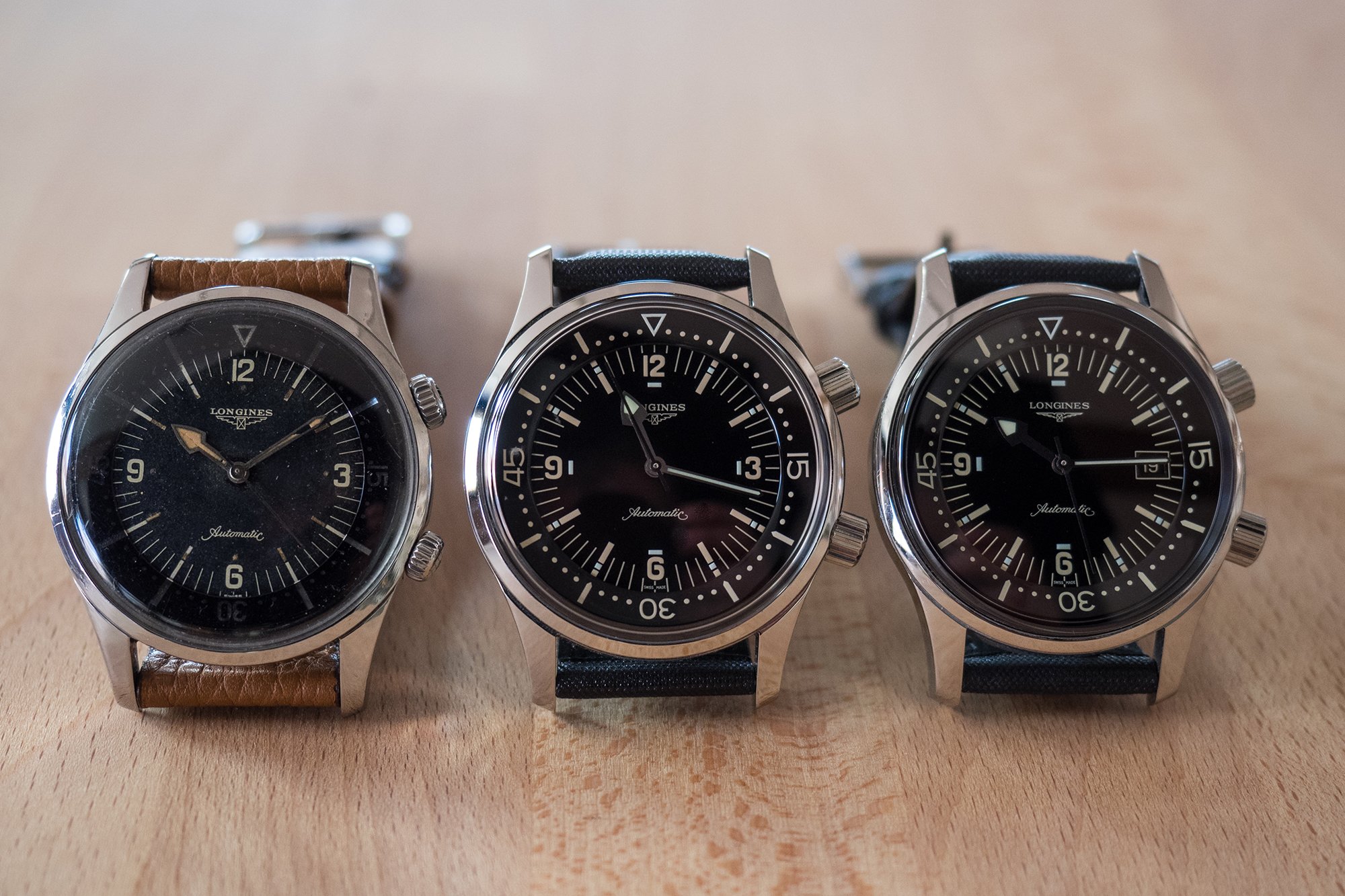
The Longines Nautilus Skin Diver reference 6921
The Longines Nautilus Skin Diver reference 6921 was the Swiss watch manufacturer’s first dive watch. It featured a 40mm stainless steel case. Inside this robust case was a 19AS automatic calibre that comprised 19 jewels and performed at a rate of 18,000 vibrations per hour. Its automatic rotor took up a considerable amount of space whilst the movement itself sits smaller and thicker inside the case, with traditional perlage decoration applied to its surfaces. The movement was first introduced in the year 1952 and was used in several watches within Longines’ catalogue during this time.
The case of the Nautilus Skin Diver reference 6921 was developed with special patented case-sealing “Compressor” technology developed by Ervin Piquerez, S.A. (EPSA) for improved water resistance, making it an advanced dive watch feature for its time. It meant that the deeper the diver went, the more pressure was applied to the back of the case, pressing it firmly against a special O-ring gasket to trap out water. It was thanks to this special Compressor case that the watch could offer 150-meter water resistance. The external bezel in black, made from Bakelite, assisted the wearer with measuring elapsed time whilst underwater, whilst the back of the case boasted a unique engraving of a diver with a harpoon. The Longines Nautilus Skin Diver reference 6921 was only in production for two years, finishing at the end of the 1950s. It’s also believed that only 550 models were ever released, making these vintage Longines diver watches incredibly rare and sought after today.
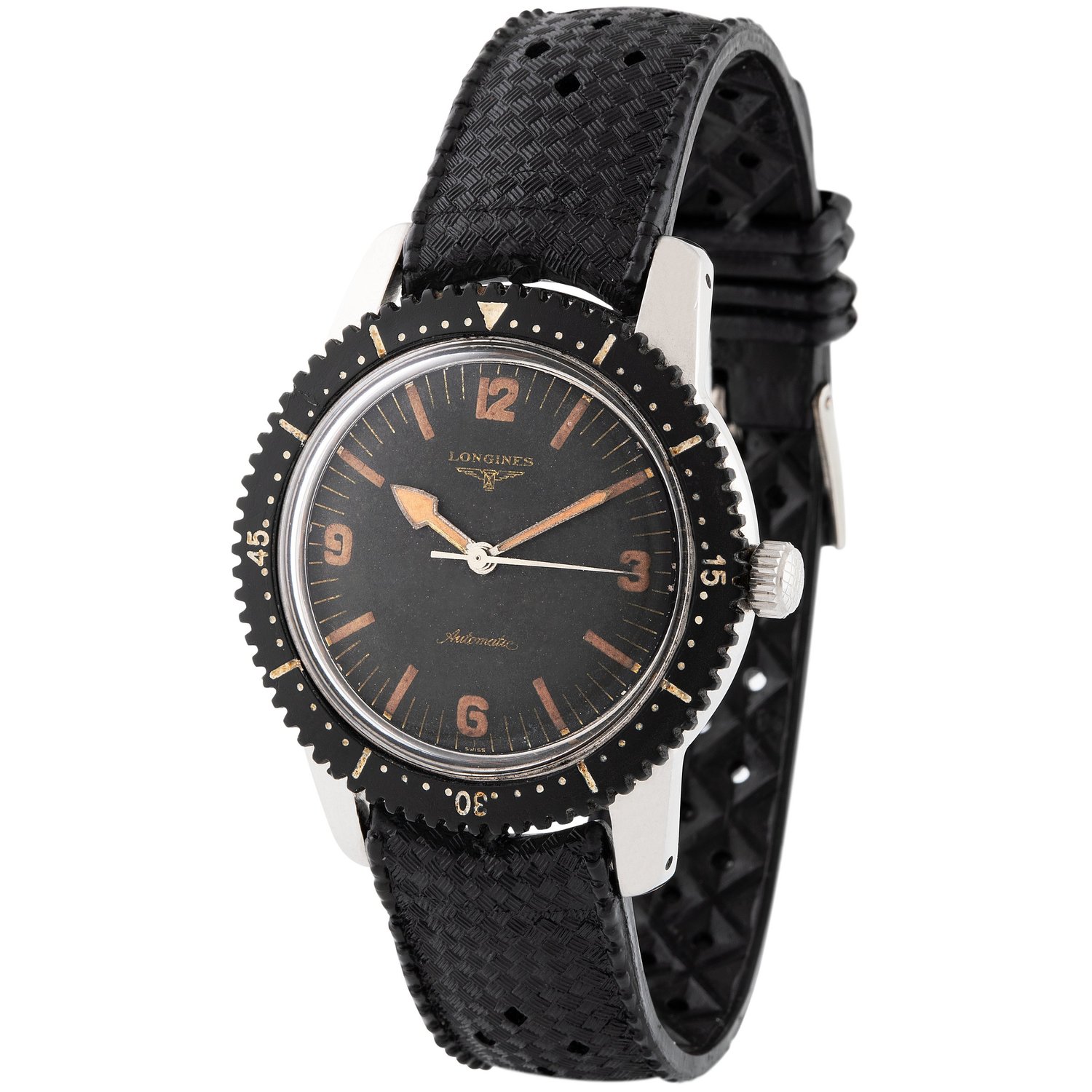
Longines Nautilus Skin Diver
Reference: 6921
Case/Dial: 40mm Stainless Steel, Black
150
Movement: 19AS, Automatic
Functions: Date
Strap: Rubber
Style: Military
Longines Super Compressor reference 7042
Similar to the Longines Nautilus Skin Diver reference 6921, the Longines Super Compressor 7042 was constructed from the same EPSA Compressor case. It featured an internal bezel and dual crown model, however, whereas the Skin Diver 6921 featured a single crown with a simple crosshatch pattern. With 100-meter water resistance, the stainless steel case measured a broader 42mm diameter and was released in 1960. It is one of the earliest dive watches with an inner rotating bezel and is powered by the automatic calibre 19AS. The 2 o’clock crown works to rotate the internal bezel, whilst its glossy black dial features Arabic numerals at 12, 3, 6 and 9 o’clock. Although rare on the pre-owned market, there is an even earlier and rarer model with radium lume dot hour markers replacing the familiar Arabic numerals. Later editions of reference 7042 utilized tritium lume. The watch was produced only for a few years between the late 1950s and early 1960s, resulting in only a few that have survived in a desirable, good condition.
Today, Longines’ catalogue is home to many vintage-inspired military and dive watches that have been reimagined for 20th-century collectors. These are found within the Longines Heritage watch collection, with several faithful reinterpretations that capture the spirit of Longines watchmaking from a bygone era, enhanced by some of the manufacturer’s most successful modern horological feats.
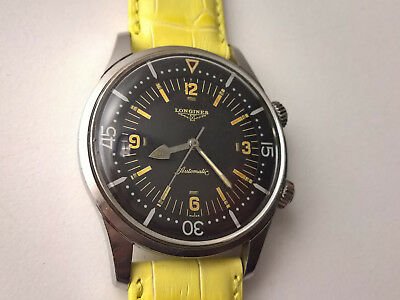
Longines Super Compressor
Reference: 7042
Case/Dial: 42mm
100
Movement: 19AS, Automatic
Strap: fabric
Style: Military